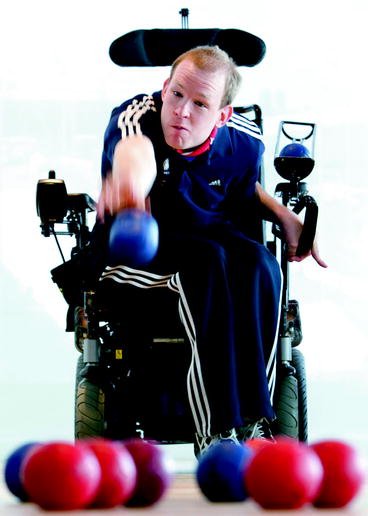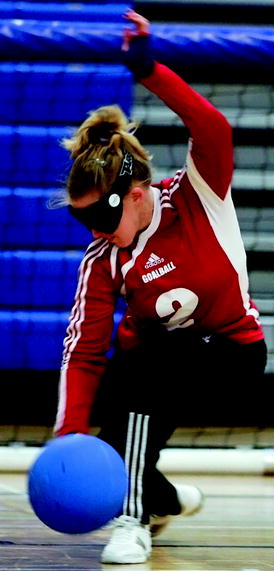Sport
Boccia
Goalball
Sitting volleyball
Wheelchair basketball
Wheelchair rugby
Impairment
Cerebral palsy
Visually impaired
Multiple
SCI, amputee
SCI
For the purposes of fair competition, athletes need to be assessed for eligibility to compete, that is, meeting the minimum disability requirement and then stratified into groups. This process is termed classification and is specific for each sport and will be discussed individually, but the general concept is equivalent to classifying athletes in able-bodied sport by gender, age or weight. The process determines the impact of the impairment on function specific to the sport and then athletes are grouped for competition.
12.2 General Principles Relating to Injury
The literature surrounding injury in disability or Paralympic sport is limited, and papers commonly describe multiple sports and impairment types together [1–6]. The terms ‘wheelchair sports’ or ‘wheelchair athletes’ are often used in the literature, but this makes interpretation of injury patterns in individual sports more challenging. This terminology is being challenged in the desire for more sport- and disability-specific injury information [7], but a comprehensive review fully describes the available literature and its limitations [8]. However there may be some similarities between the wheelchair ball sports of rugby and basketball where contact of the hand or wrist with the chair rim or an opponent’s chair is the most commonly reported mode of injury. Many of these injuries do not require medical treatment and are not defined as injury in some studies. Contact/collision injuries and the mechanics of wheelchair propulsion may precipitate upper extremity injuries in wheelchair athletes.
There are some studies investigating wheelchair propulsion technique as a risk factor for median nerve neuropathy or other pathologies in wheelchair athletes. Nerve conduction studies comparing elite wheelchair racers (athletics) to the general wheelchair-using population have found that athletes had a similar or lower incidence of median nerve neuropathy [9]. No studies have documented the incidence in wheelchair rugby or basketball, but acute median nerve responses have been assessed using ultrasonography following intense wheelchair propulsion in wheelchair basketball [10]. Wheelchair users with different levels of cervical spinal cord injury will adopt different propulsion techniques to utilise the available muscles most efficiently. It has been suggested that quadriplegic athletes may be more susceptible to tendinitis at the wrist through the use of a ‘backhand’ method of wheelchair propulsion, which allows those with higher-level lesions to engage their stronger muscles in force production. The gloved back of the hand pushes the wheel rim, producing a forced passive flexion action followed active wrist extension and forearm supination [11]. The study of different push mechanisms and interaction between players with different impairments and the wheelchair is complex [12].
The impact of the injury on the individual may also have a greater significance because of the impact of an injury on the ability to perform activities of daily living. This aspect will need to be considered in the management plan of any injury. Injuries will relate to the mechanics of the sport, the equipment used and the existing impairment of the athlete. Management of particular injury types will not be covered in this chapter but refer to the relevant section in this text, but the clinician needs to have an understanding of each sport and these are described below.
12.2.1 Boccia
Boccia is a sport for athletes with severe cerebral palsy or related neurological conditions and is similar to the game of boules. Competitors throw a soft leather ball (weight 275 ± 12 g and 270 ± 8 mm in circumference) trying to get as close as possible to the ‘jack’ ball. A throw is the term used for propelling a ball onto court and does not just include throwing but also kicking or releasing a ball with an assistive device such as a ramp. There is no Olympic equivalent. It is also known as bocce and it derived its name from the Latin word for ball (‘bottia’). Boccia made its first appearance in Paralympic Games in 1984 and has mixed gender competition with singles, pairs and team events using six balls per game. The playing court is a flat, smooth surface and usually a wood gymnasium floor with an area of 12.5 × 6 m marked out with tape and this includes the throwing area that is divided into six throwing boxes. On the court is a V-shaped line over which balls must cross for the throw to be valid. A cross marks the position where the jack must be placed if it touches or crosses the boundary line or in the case of a tie break. Players are classified into four classes depending on their functional ability: BC1, BC2, BC3 and BC4 (Fig. 12.1).


Fig. 12.1
Boccia competition
Boccia is a target sport requiring high degrees of accuracy and concentration. All players are wheelchair users and use their normal day chair for competition in most cases. The nature of the disabilities involved mean that altered muscle tone, impaired coordination and strength make this a challenging sport for the individual and control of ball release is critical. Repetitive movements or practice throwing can lead to pain in the wrist and tendon problems. Botulinum toxin type A has been used to alter tone and to improve functional action in the hand in children with cerebral palsy and it could potentially be used in the boccia player but no case reports have been described as yet [13].
12.2.2 Goalball
Goalball is one of the sports unique to the Paralympics having been devised in 1946 as an activity for blind war veterans. It involves a team of three players defending a goal against a ball thrown by the opposing team. The ball contains a bell so that the defenders can hear the ball and throw themselves in the way to defend their goal. Spectators must be silent during play to enable the players to hear the ball. It was introduced to the Paralympics in 1976 in Toronto as a demonstration sport but has been an official Paralympic sport since 1980 with over 112 countries participating in the sport worldwide. It is governed by the International Blind Sports Association (IBSA).
There are competitions for male and female visually impaired athletes. Although competition is open to any of the IBSA visually impaired classes B1–B3 as detailed below, all athletes must wear blackout goggles, which eliminates any vision.
B1: Total absence of perception of the light in both eyes, or some perception of the light but with inability to recognise the form of a hand at any distance and in any direction
B2: From the ability to recognise the form of a hand to a visual acuity of 2/60 and/or a visual field of less than 5°
B3: From a visual acuity of above 2/60 to a visual acuity of 6/60 and/or a visual field or more than 5° and less than 20° (Fig. 12.2)

Fig. 12.2
Goalball player – note blackout eyeshades
At Paralympic Games the men’s event has 12 teams in two pools of six and go on to a knockout stage, while women have 8 teams in one pool and play a round robin. Each match has two 10-min halves with a 3-min break in between. In case of a tie, after the end of the regular time, two additional overtime periods of 3 min each are played. If the match is still tied at the end of overtime, free throws are taken. The playing surface is a gymnasium floor marked with a rectangle 18 × 9 m. There are areas for each team in front of their goal and a central ‘neutral’ area with all markings being made tactile with tape to enable the players to orient themselves on the court. Goals measure 9 m (equal to the width of the court) × 1.3 m high. The ball is made of rubber, weighs 1.25 kg with a circumference of approximately 76 cm and has with eight holes and noise bells inside. All competitors must wear eyeshades at all times on the court. At all major competitions, all players shall have their eyes covered by gauze patches under the supervision of the IBSA Goalball Technical Delegate, and penalties are given if a player touches the eyeshade during play. There are certain sport-specific rules concerning the manner of throwing:
A thrown ball must touch the floor of the court before passing over the highball (or centre) line, which is the line 6 m from the goal line at the thrower’s end.
A throw must take place within 8 s of coming under the control of the defending team. Passing can take place within the 8 s, and players may move about the court to adopt favourable positions.
No player may take more than two consecutive throws for his team.
As the players dive to prevent the ball from entering their goal, they impact on the floor, goal or another player. For protection they can wear padded clothing from injury as they dive about; however, the padding may not extend from the body more than 10 cm. However due to the nature of the sport, injury may occur from direct contact with the floor, goal frame, opponent or by contact with the ball thrown by an opponent. Using a spin and throw technique, the 1.25 kg ball travels at speeds over 25 m/s and can cause direct injury to the finger or wrist [14]. The spin and throw technique can also lead to overbalancing in the less trained athlete and lead to a fall on the outstretched arm.
12.2.3 Sport-Specific Medical Rules
Medical Time Out: In the case of injury or illness, a medical time out shall be called by a referee and the 10 s timer closest to the injury player shall start a clock to record the 45 s. An audible warning will be given to the referee at the expiration of the 45 s. If the injured player is not prepared to play at the expiration of 45 s or if any member of the team enters the court, that player must be substituted until the end of that half of play.
Medical Treatment: During any half of play if it is necessary for any player to leave the FOP for medical attention or equipment adjustment, the player can leave only at an official stoppage in play and may not return to the FOP until the expiration of that half.
Blood Rule: Should at anytime during a game a player receive an injury where blood is observed by the referee, the player will be immediately removed from the court and may not be permitted to return to the court unit the following has taken place:
Bleeding must be stopped.
The open wound covered.
If there is an excessive amount of blood on the uniform, it must be changed.
12.2.4 Volleyball (Sitting)
Sitting volleyball evolved in Holland in the 1950s from a combination of volleyball and ‘sitzball’, a game played in Germany. As it developed internationally, it came under the governance of the International Sports Organisation for the Disabled and made its first appearance in the Paralympic programme in 1980 in Arnhem. The international federation is now the World Organisation Volleyball for Disabled (WOVD). Sitting volleyball is an adaptation of standing volleyball played from a sitting position in a reduced court area and with a lower net. The aims of the game are similar, that is, to get the ball to touch the floor in the opponent’s court area using your own team of six players to keep the ball in play on your side before playing the ball over the net. Only three contacts or passes are permitted on one side of the net, not including blocks. At all times players must have their pelvis in touch with the floor.
Stay updated, free articles. Join our Telegram channel

Full access? Get Clinical Tree








